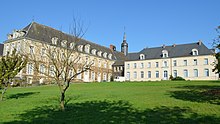Melleray Abbey

Melleray Abbey (
History
Foulques, abbot of Pontrond in
Guitern, the first abbot, erected the original monastery in 1145, but the church was not completed until 1183, under Geffroy, the fourth abbot.[2]
A small monastery built for about twelve monks, Melleray remained regular in observance until during the sixteenth and seventeenth centuries, when relaxation prevailed. Etienne de Brezé (1544) was the first
This, however, was not the end of Melleray. The
Although much of the soil of their property was stony and sterile they applied to it the skill learned from the improved methods of English farming, introducing new types of plows and the first threshing machine ever used in Brittany.
Under Antoine II several monasteries were established, among them
In 2015, the Trappist monks announced that they would leave the abbey in 2016, and give charge of it to the Chemin Neuf Community.[5][6]
See also
References
- ^ a b Hoffmann, M.M., Arms and the Monk! The Trappist Saga in Mid‑America, Dubuque, Iowa, Wm. C. Brown Company, 1952
 This article incorporates text from this source, which is in the public domain.
This article incorporates text from this source, which is in the public domain.
- ^ a b c Obrecht, Edmond. "Melleray." The Catholic Encyclopedia Vol. 10. New York: Robert Appleton Company, 1911. 22 January 2023
 This article incorporates text from this source, which is in the public domain.
This article incorporates text from this source, which is in the public domain.
- ^ "Historique", Chartreuse de La Valsainte (Suisse)
- ISBN 0964280213
- ^ Ouest-France, ed. (August 28, 2015). "Religion. Qu'est-ce que la Communauté du Chemin neuf ?" (in French). Retrieved August 28, 2015..
- ^ "Melleray Abbey", Office de Tourisme Intercommunal de Châteaubriant - Derval
- Attribution
 This article incorporates text from a publication now in the public domain: Herbermann, Charles, ed. (1913). "Melleray". Catholic Encyclopedia. New York: Robert Appleton Company. The entry cites:
This article incorporates text from a publication now in the public domain: Herbermann, Charles, ed. (1913). "Melleray". Catholic Encyclopedia. New York: Robert Appleton Company. The entry cites:
- MANRIQUE, "Annales Cistercienses" (Lyons, 1642);
- JANAUSCHEK, "Originum Cistercienium" (Vienna, 1877);
- HAUREAU, "Gallia Christiana", XIV (1856);
- MORICE, "Preuves de l'Histoire de Bretagne";
- FELIX, "Notice sur l'Abbaye de Melleray" (Nantes, 1884);
- DE CORSON, "L'Abbaye de Melleray avant la Revolution" (St. Brieuc, 1895);
- "Vie du R. P. D. Antoine" (Paris, 1840);
- GAILLARDIN, "Les Trappistes de l'ordre de Citeaux au XIXe s." (2 vols., Paris, 1845);
- RICHER, "Voyage par un Trappiste de 7 Fons" (Paris, 1870); "Grandmaison y Bruno" (Paris, 1852);
External links
![]() Media related to Abbaye Notre-Dame de Melleray at Wikimedia Commons
Media related to Abbaye Notre-Dame de Melleray at Wikimedia Commons
